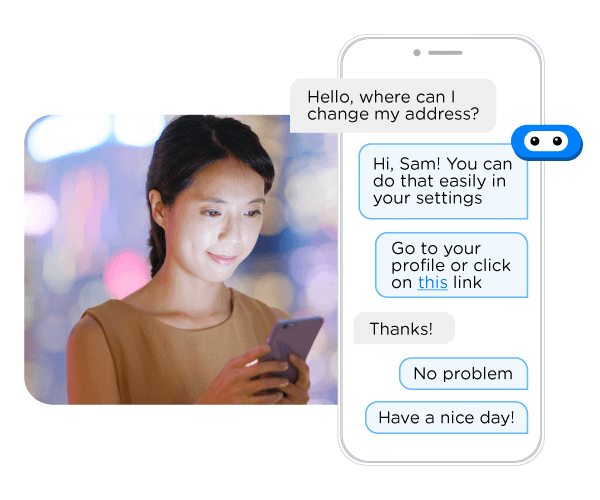AI automation and chatbots have made great strides in recent years. An AI chatbot’s ability to learn and find its own answers to more complex questions can make up for some of the conversational limitations of a scripted ‘bot. Regardless of this, however, there are broader issues to consider. To make sure your chatbot implementation is a success, there are four key components you should need to know about.
1. Personalised Experiences
Chatbots need to be able to interact with customers on a personal level. Research revealed that 55% of consumers think personalisation is a crucial aspect of customer communications, 35% expected personalised customer service interactions, and 28% wished for a tailored website experience.
With AI, all of the above is possible. In particular, CM.com's Conversational AI Cloud makes it simple for non-technical users to build the chatbot, design the flows, give the 'bot its own tone of voice and personalise conversations without needing a developer in the room. That’s because the platform drives interactions through content rather than APIs.
Yet, to take personalisation to the next level, a developer can connect the chatbot to customer information. This integration means the chatbot can pull data to hyper-personalise experiences; a customer's order history, date of birth, or even their address for example.
That personal touch doesn’t begin and end with chatbot interactions, however. With live chat, exchanges can be handed from the chatbot to your customer service team, arming human agents with the knowledge gained from the automated part of the conversation.

2. Transactional Interactions
Being conversational isn’t about discussing the weather with customers. Your chatbot needs to help drive customers toward their goal, whether a sign-up, a download, a purchase, or even just quickly getting the answer they need.
The chatbot’s AI-driven algorithm can classify user input by intent, comparing that input to the example phrases the chatbot’s owner has added to train the model.
These phrases could be things like:
I want to buy a pair of jeans
I need to change my address
Can I book an appointment?
Where is my payment?
Buy iPhone 13 Pro Max
Natural Language Processing, or NLP, is used to decipher intent and produce appropriate answers, ultimately helping the user reach their goal. With the right connections, chatbots can update customers on the status of their enquiry, or even let them buy a product within the chatbot conversation.
3. Omnichannel Communication
Providing the same chatbot experience across a variety of channels is vital for consistency, and consistency is the cornerstone of any successful brand. Your customers expect to be treated the same way whenever they interact with you, regardless of platform.
Conversational AI Cloud is a channel-agnostic platform which means you can implement and optimise once across all channels saving huge amounts of development time. We know different platforms lend themselves to different ways of presenting content – a voice-based channel vs, for example, WhatsApp – but the expectation is always the same; an accurate and rapid answer to the question posed to the chatbot.
While Conversational AI Cloud makes short work of a consistent voice and experience across all channels, if you want to push a particular type of chatbot content more heavily on a specific channel, there are tools available for you to do just that, meaning customers can benefit from WhatsApp’s interactive messaging features, or SSML for voice-based channels.
And, since the data from all channels is funnelled into one analytics environment, it’s easy to see what’s working and what isn’t across every channel you curate. Finally, because the platform is channel-agnostic, you can integrate Conversational AI Cloud with your CRM system in one process rather than repeating the integration whenever you need to connect a new channel.

4. Conversational Messaging
Consumers' expectations of online conversations are evolving. Nowadays, consumers chat with family, friends and colleagues every hour, using non-formal language and emojis to add emotion. These conversations are easy, fluid and comfortable. A chatbot needs to be able to meet these expectations and interact with familiarity, making users feel secure and comfortable in the conversation. Being conversational means your chatbot can follow normal conversational norms and achieve a desirable outcome.
Conversational AI Cloud has conversational design at its core. All content is based on question-and-answer sets, meaning users can easily build content to create natural conversational flows. Gap analysis helps to identify areas where the chatbot isn’t providing satisfactory responses, and users can easily create new flows in a simple drag-and-drop environment. Chatbot responses can vary between simple text responses and rich multimedia content, and no coding or developer knowledge is required to build new flows.
This adds up to a simple, easy-to-use interface that’s powerful enough to ensure your chatbot can understand your customers, get the answers they need quickly with minimal effort and find what they need without them having to queue for a human agent.
Building great chatbot experiences
To create a great chatbot experience, it’s important not to lose sight of the ultimate goal – building a frictionless journey for your customers that gets them to where they want to be as efficiently as possible. While looking after your customers' needs, you’re also delivering on your business needs, reducing reliance (and stress) on human agents and turning customers into brand advocates.
CM.com's Conversational AI Cloud offers 20 'out-of-the-box' dashboards to help you achieve these chatbot experiences. From Gap Analysis, Answers, Recognition Analysis and Interaction Explorer dashboards, you can continuously optimise the customer journey to build the best chatbot experience.
If you’re serious about chatbots, our experts can help your business get it right the first time and keep getting it right. Let’s schedule a call and determine the best way forward for you and your team.








